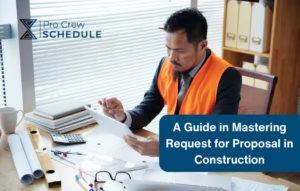In managing construction projects, professionals know that time is money. A slight delay in the project timeline means more overall cost project cost. For this reason, contractors have made it a point to accurately and efficiently schedule their project timelines. One way to do this is by using the Critical Path Method (CPM) in managing the project timeline and using it as a guide in going about the milestones and everyday tasks.
The Critical Path Method is a framework that helps construction managers identify and track the sequence of tasks needed to achieve specific project milestones. CPM’s philosophy is that all tasks in a construction project are interdependent on one another and follow a particular order.
In construction, some tasks are critical, and some are flexible. As a tool, the CPM helps the construction manager identify and sequence these tasks in order, increasing the likelihood of finishing the project on time.
What are the Advantages and Disadvantages of Critical Path Method in Construction?
The Critical Path Method in managing construction projects is considered one of the most efficient ways to keep a project on schedule and organized. This involves identifying the essential milestones of the project and knowing how they interact with one as they move towards completion. It also requires having an accurate idea of how much time each task takes to plan the order of operations accurately.
Here are the positive and negative aspects that you should know about CPM in construction:
The positive side of CPM:
- Better predictability of future construction projects
- Organizes complex, large, and multi-tasked projects
- Provides visual understanding for the team regarding what needs to be done that aids in the execution and sequence of activities
- Identifies the start and end time of activities, as well as the slack and lag time between them
- Higher visibility for activities, schedule changes, dependencies, and their overall impact on the project in general
- Allows accurate task and crew schedule management, as well as delegation
- Increases workforce productivity and, at the same time, decreases project cost and duration
The negative side of CPM:
- Numerous manual tasks and management work
- Complicated and time-consuming, especially for a larger, multi-tasked project
- Cannot modify or create new schedules for those involved in the project activities
- · It can be difficult to manage without construction scheduling software for large-scale projects
- Does not consider resources and asset allocation
- Not flexible with sudden and unforeseeable project changes. If an activity on site is delayed or changed without warning, remapping and altering the entire CPM chart can be challenging and time-consuming
- Identifying the critical path of a project can be difficult if multiple paths are similar to one another
- For larger projects, it can be overwhelming for all stakeholders to see and understand the critical path and schedule dependencies and how they are connected\ to one another
How Do Construction Managers Organize a Critical Path Method Schedule?
Now that we have discussed the two sides of CPM, we can now proceed in diving into how to make one. Here is a step-by-step guide on how to make one for your next construction project:
1. Start with a clearly defined scope of the project, then decompose these scopes into separate phases:
a. Preconstruction Phase
- Site survey
- lot layout
- permit submission, and
- approvals
b. Sitework and Utility Phase:
- Earthmoving
- site balance (land cut and fill),
- service utilities
c. Footings and Foundations Phase:
- Excavation,
- piers,
- pilings,
- footing work, and
- foundation work
d. Structural Framing Phase
- Structural steel erection,
- exterior and interior framing
e. Mechanical, Electrical, and Plumbing Phase:
- Rough-in Mechanical, Electrical, and Plumbing installations; and
- Data cabling and telecommunications, if necessary
f. Features, Fixtures, and Finishes Phase:
- Exterior painting and glazing and interior partition installation
- MEP and telecommunication systems finish
- Interior features, glazing, fixtures, and finishes
- Landscaping and other site beautification works
2. After that, decompose these project phases into work breakdown structures (WBS) by breaking down every project activity within the phases into smaller tasks.
3. Estimate the needed time to complete each of these tasks.
a) Accurate task-time estimation is vital when creating an accurate CPM schedule. Input your time-task estimate in construction scheduling software for easy reference.
b) Integrate a project management information system (PMIS) to pull needed data from previous construction projects with similar WBS for reference.
4. After WBS, establish task dependencies.
a) Further, decompose the work breakdown structures by identifying their tasks dependencies
- In construction, dependencies define the work operations order for each WBS task.
- Work packages must progress logically and orderly to avoid disruption.
5. Next, create a Critical Path Diagram for your construction project.
a) With a clearly defined project scope, sequenced task dependencies, and accurate time durations for your tasks, you’re ready to create the critical path diagram.
b) CPM is a visual representation of the significant milestone activities of the project, laid out in chronological sequence.
c) Many milestone activities overlap, so a visual process diagram is an essential project management tool.
6. Lastly, Identify your critical path: Each major project milestone activity has four parameters.
a) Earliest start time (ES): An activity’s earliest start depends on the earliest finish of that activity’s previous dependent task.
b) Latest start time (LS): Compute the latest start time by subtracting the current activity time from the latest finish time.
c) Earliest finish time (EF): By adding the activity duration to the earliest start time, you can determine the earliest time the activity can finish.
d) Latest finish time (LF): This refers to the latest time a certain activity can be completed without delaying the project
How to Stay on Track in Your Critical Path Method?
As we all know, managing construction projects involves juggling many tasks at any given time. So, how can you stay on track on the critical path in your construction projects? Let’s take a look at these three important considerations.
1. Define All Your Project Tasks
The first and most important step toward staying on the critical path of your project is gaining full clarity on your major task milestones. These inform all the other aspects of your project organization protocols. You cannot accurately plan unless you and your construction team know precisely what activities depend on each task towards completion. This isn’t just about identifying the activity titles, defining what is involved in each task, and identifying subtasks.
One of the best approaches to this is to work alongside appointed key representatives of all construction departments. While the overall project head will have a good overview of major components in construction, their expertise in each will be limited to a bird’s eye view. On the other hand, department managers and supervisors of specialized areas and trades have a more in-depth knowledge of the tasks in their field that can impact the project. Furthermore, they can also identify how these tasks relate to and depend on the completion of other tasks and departments.
2. Set Realistic Timelines
Another critical component of staying on the critical path of your project is getting your task timing right. The key word here is realistic. Most of the timings you estimate are likely the result of opinions you developed over years of experience in the industry. However, there is a danger of being too optimistic or even ambitious due to this.
Mistakes can happen even in the best situations. With overly confident subcontractors, there may also be the possibility for optimism bias that can lead to cut corners and overlooked hazards. Effective measures, such as effective time management training, can help mitigate such issues with scheduling. However, accounting for these potential hurdles in task-timing your critical path is vital.
So, always bear in mind your best-case scenario, but give yourself potential room for errors. This way, there’s a reduced possibility to crunch activities at the end of the project to keep the deadline.
3. Organize a Visible Sequence
When it comes to the critical path in construction, having a visible sequence in place is everything. The project manager is responsible for ensuring that each task is aligned with the technological order of construction. By common sense, it would be unreasonable to bring in painters before the foundations have been completed. Still, this CPM sequence also needs to account for the relationship to other tasks that are occurring at the same time.
Key Takeaway
The critical path method continues to be one of the most efficient ways to bring a construction project to success, and no traditional or modern era can change this. As with any construction project, remember that it does not pay to be too rigid. You can still be organized while remaining flexible and agile enough to respond effectively to challenges, and this can be easy with the help of construction scheduling software, such as Pro Crew Schedule.







